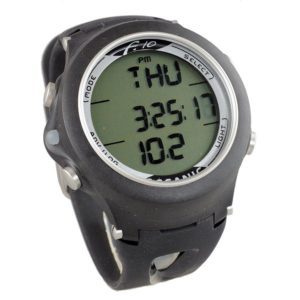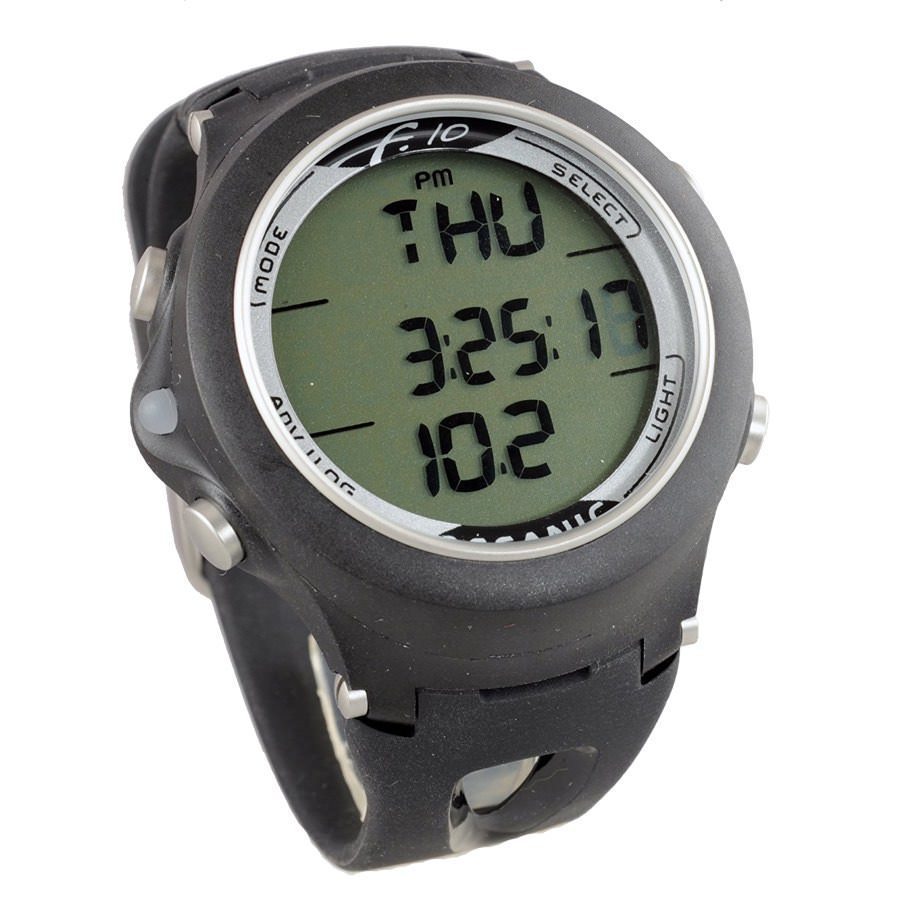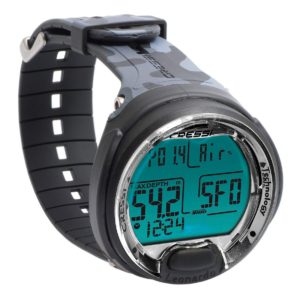
Updated November 24, 2024
Freediving has increased in popularity by leaps and bounds recently. As has happened in scuba diving, the limits are getting pushed further and further. For the serious freediver, a watch or computer can go a long way in not only maintaining safety but also as a tool for training. Real-time data about the environment and your performance during the dive lets you know where you stand and then afterward you have a record that you can analyze and plan from.
Below is a buyer’s guide followed by a number of freediving watch options that I have reviewed to help you more easily make the decision on which one would work best for you. There is a range from the simplest freediving watches all the way up to models suitable for freediving as well as more advanced and technical levels of scuba diving. Videos have been provided for all the models except one to help fill in the gaps in the written material. After that is a comparison table of the reviewed watches, to summarize some of the key features.
If you have any questions or concerns, please use the comments section at the bottom. I’d love to hear your thoughts.
Best Freediving Watch Buyer’s Guide
Modes
Some extremely specialized freediving watches are suitable only for freediving. Many are more versatile and include gauge, air, nitrox, and/or trimix modes. If you are involved in freediving and scuba diving there is a selection of modes available for the sports you want to participate in without having to purchase two watches.
Depth
Like scuba divers, freedivers are continuously increasing the depth of their dives. Today’s dive watch should be operational at depths of at least 330 feet (100 meters).
Dive Logs/Memory
A major function of a dive watch is the logging of the data from your dives. Particularly if you dive a lot, a watch that can track more dives over a longer period of time will be more convenient.
User-Friendliness
It is important to be able to easily use your dive watch. The display needs to be clear and easily readable. Backlighting can be a good feature in poor visibility. Audible alarms need to emit a sound loud enough to hear over boat motors, waves, and other ambient sounds. Often these alarms are regarding surface intervals, depth limits, breath-hold training, or hydration which are significant to be aware of.
Freediving versus Scuba Computers
A scuba computer won’t necessarily be suitable for freediving. One reason is depth ratings. Top-class freedivers can go very deep, much deeper than recreational scuba diving limits. Some scuba computers can’t function properly beyond a certain depth. Also, alarms for ascent rates for scuba divers won’t be applicable to freediving where faster ascents are acceptable and don’t have barotrauma and decompression implications.
Quality and Durability
Brand-name watches are more likely to have the best materials, designs, and craftsmanship that will help to ensure durability and comfort.
Best Freediving Watches
- Sherwood Amphos
- Oceanic F10
- Oceanic Geo 4.0
- Cressi Leonardo
- Mares Smart
- Omer Compact UP-X1 (with Heart Rate Monitor)
- Tusa Talis
- Pyle Multifunction Sport Watch
- Suunto D4i Novo
- Best Use: scuba divers who also free-dive
- Modes: air, nitrox, gauge, free-dive, and watch
- User Changeable Battery: Yes, CR2430
- Memory: 24 dives
- Features: USB cable enables connection to your computer and downloading of logbook info, DSAT decompression model, selectable audible alarms for different actions and gases, deep stop and safety stop countdown
- Rating: 4.6
- Price: $$$$
Pros: air integrated for scuba diving eliminating gauge and hose, simple design with easy navigation
Cons: expensive
- Best use: free-dive training
- Modes: free-dive, and watch
- User Changeable Battery: Yes, CR2430
- Memory: 99 dives
- Features: free dive mode shows depth and elapsed dive time, user-defined surface recovery timer, repeating dive time and depth interval alarms, 3 maximum depth alarms
- Rating: 4.7
- Price: $$$
Pros: alarms and display great for free dive training
Cons: good for freediving, not so good for scuba diving
- Best use: nitrox and advanced divers
- Modes: air, nitrox, gauge, free, and watch
- User Changeable Battery: Yes, CR2430
- Memory: 24 scuba dives or 99 free dives
- Features: 2 algorithms, 2 Nitrox mixes up to 100% oxygen, firmware auto-updates, audible alarms, gauge mode with run timer, last dive display for maximum depth and dive time, comes with DiverLog+ app to connect with your smartphone
- Rating: 4.8
- Price: $$
Pros: PC compatible, DiverLog+ app, durable, stylish, easy navigation through the menus
Cons: many complaints about the poor user manual, suggest checking out the Oceanic video below
Best use: nitrox and advanced divers
- Modes: air, nitrox, and gauge
- User Changeable Battery: yes, CR2430
- Features: oxygen toxicity indicator, user-adjustable conservatism levels, easy to program single button navigation with large digits, imperial or metric
- Rating: 4.5
- Price: $$
Pros: high-definition screen, has a battery save mode, ability to reset, low price
Cons: computer interface not included
- Best use: freediving and watch
- Modes: air, nitrox, and free-dive
- User Changeable Battery: Yes, CR2430
- Memory: 36 hours
- Features: ergonomic design, attractive styling, 7 color combinations, calendar, dual time zones, alarms
- Rating: 4.7
- Price: $$$
Pros: easy to read display
Cons: watch straps are a little short to fit over some cold water wetsuits
Omer Compact UP-X1 (with Heart Rate Monitor)
Best use: free-dive training
- Modes: freediving and watch
- User Changeable Battery: no, it’s rechargeable, has a power-save mode
- Memory: 250 dives
- Features: 4 buttons and 6 screen modes, carbon fiber face ring, heart rate monitor and USB, multiple alerts, automatic dive mode
- Rating: 4.6
- Price: $$$$
Pros: can use heart monitor for other sports, as well,
Cons: a little expensive
- Best use: freediving and watch
- Modes: air, nitrox, gauge, free-diving, and watch
- User Changeable Battery: yes, Cr2450
- Memory: 24 dives
- Features: two gas switching, 4 button menu navigation, variable ascent rate indicator, time to fly and desaturation countdowns, comes in white or black
- Rating: 4.8
- Price: $$
Pros: many features at a reasonable price
Cons: 24 dives of memory is not a lot
Pyle Multifunction Sport Watch
- Best use: freediving and watch
- Modes: freediving and watch
- User Changeable Battery: yes, Cr2
- Memory: 100 hours
- Features: 5 modes include the current time, dual time, chronograph, countdown timer, underwater diving, automatic activation, long battery life, alert for fast ascents
- Rating: 4.4
- Price: $
Pros: very low price, colorful styling
Cons: watch band is a bit short
- Best use: scuba and freediving
- Modes: air, nitrox, free, and off
- User Changeable Battery: yes, Cr2450
- Memory: 140 hours
- Features: has apnea, air, and nitrox timers, optional wireless gas integration, compact styling, 9 colors available, has scratch guards, includes a USB cable, audible, visual depth, and time alarms
- Rating: 4.9
- Price: $$$$
Pros: versatile, quality construction, and features
Cons: if you find a problem, please let me know
Freediving Watch Comparison Table
For reviews on scuba diving computers and watches, please check out these posts:
Feedback and Comments
I hope you have found this review of freediving watches to be useful. If you have any questions, ideas, or personal experiences, please feel free to share them in the comments. If there is no comments section directly below, click here: >>comments<<

















